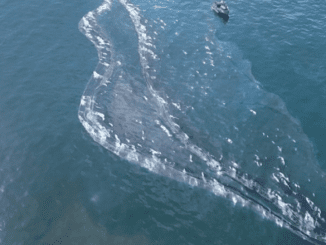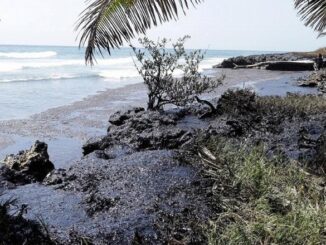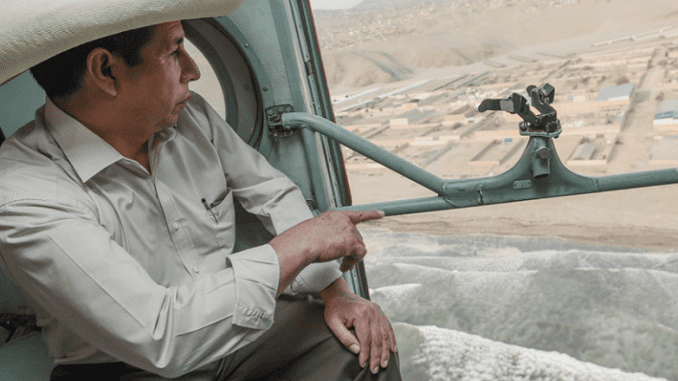
LIMA, Peru, January 20, 2022 (ENS) – Peru’s President Pedro Castillo today signed a decree declaring a climate emergency due to an oil spill triggered by last week’s volcanic eruption at the Pacific island nation of Tonga, and the resulting tsunami.
The decree was signed near the capital city Lima at Cavero Beach in Ventanilla this afternoon, where President Castillo was supervising the oil spill cleanup.
The spill of 6,000 barrels of oil at the Repsol company’s La Pampilla refinery in Ventanilla last Saturday, January 15, has impacted the plants and marine animals of the coastal ecosystem. Based in Madrid, Spain, Repsol is a global multi-energy provider with a strong interest in low-emissions energy generation and the goal of becoming a net-zero emissions company by 2050.
But, Repsol might pay a penalty for the spill as some 18 beaches have been affected and more than 500 hectares (nearly two square miles) of two protected natural areas have been damaged, the Peruvian newspaper “Peru 21” reports.
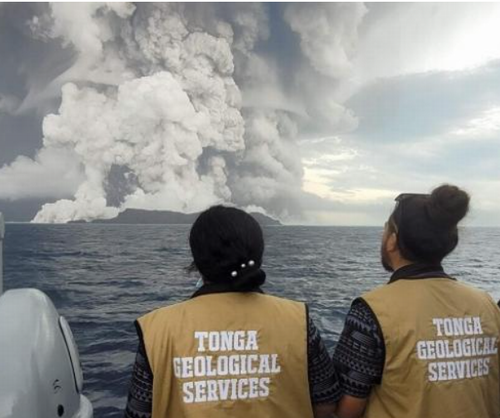
The source of the spill was the Italian oil tanker “Mare Doricum,” which was rocked by violent tsunami waves while unloading crude oil at the La Pampilla refinery, reports Raghib Raza on the ship-tracking Fleetmon website. The ship was carrying nearly one million barrels of Brazilian crude that came from a terminal owned by the Brazilian state oil company Petrobras.
The waves originated from the intense series of explosions early on January 15 almost 11,000 kilometers (6,835 miles) away in Tonga that generated atmospheric shock waves, sonic booms, and tsunami waves that traveled the world.
Several Earth-observing satellites collected data during and after the eruption. Scientists affiliated with NASA’s Disasters program are now gathering imagery and data, and they are sharing it with colleagues around the world, including disaster response agencies.
Within Peru, a probe into the spill has been launched by Peruvian prosecutors. If the responsible party is identified, fines for the environmental damage could reach US$33 million.
The environmental contamination has caused the death of birds and ocean microorganisms. Peru’s environmental authority has closed off two beaches and a National Natural Reserve to the public.
Cleaning efforts are taking place on an urgent basis. Environment Minister Rubén Ramírez said today that the Repsol company will be sanctioned if it is found that it did not have the necessary personnel and equipment to apply its contingency plan after the spill.
Ramirez has given the La Pampilla refinery two days to identify critical points and 10 days to clear away the oil.
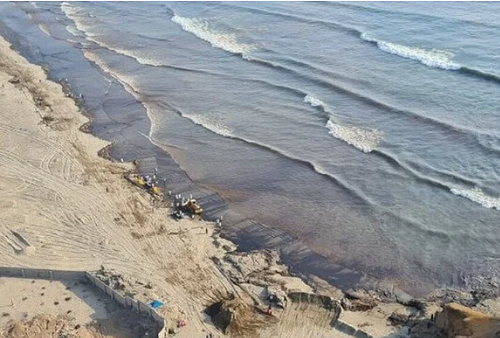
The parent company of the refinery, Repsol, and the owner of the oil terminal where the cargo was being unloaded, Petrobras, have issued no statement.
Repsol initially claimed that seven barrels of oil fell into the ocean, but the Peruvian Government said it was closer to 6,000 barrels, according to La República.
The Peruvian Navy has been criticized for failing to issue a tsunami warning, endangering the lives of fishermen, and potentially bearing some responsibility for the damaging spill.
“This can last for decades,” laments Dr. Joanna Alfaro-Shigueto, a marine biodiversity scientist and director of Pro Delphinus, a nonprofit Peruvian organization based in Lima that is committed to the conservation of threatened and endangered marine animals.
Recalling the Deepwater Horizon oil spill in the U.S. Gulf of Mexico nearly 12 years ago, Dr. Alfaro-Shigueto said, “It can vary a lot, from case to case, but if we remember what happened in the United States … there are still effects on animals and on the environment. I don’t want to be pessimistic, but from the record, we know that we do not have one of the best records in the care of the environment in the country. I hope this is not the case.”
Featured image: Peru’s President Pedro Castillo inspects damage to beaches near the capital city of Lima by plane. January 19, 2022 (Photo courtesy Office of President Castillo)
© 2022, Environment News Service. All rights reserved. Content may be quoted only with proper attribution and a direct link to the original article. Full reproduction is prohibited.

